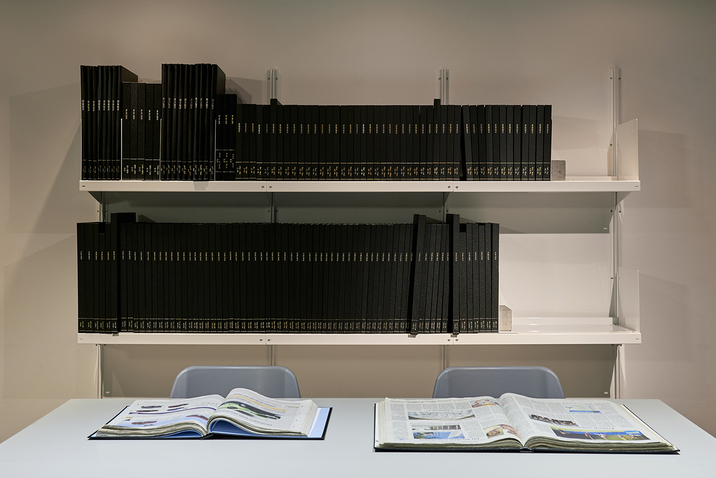-
From Current Issue
-
- Editor’s Letter Fire in the Heart
- Reviews I Gusti Ayu Kadek Murniasih
- Reviews 11th Seoul Mediacity Biennale: “One Escape at a Time”
- Dispatch Networked China
- One on One Monira Al Qadiri on Yukio Mishima
- Essays The rise of independent art spaces in pandemic-era Shanghai
- Features Tuan Andrew Nguyen
- Table of Contents
- Web Exclusives
- Archive
- Subscribe

R
E
V N
E
X
T
Installation view of BANU CENNETOǦLU’s 1 January 1970 – 21 March 2018 · H O W B E I T · Guilty feet have got no rhythm · Keçiboynuzu · AS IS · MurMur · I measure every grief I meet · Taq u Raq · A piercing Comfort it affords · Stitch · Made in Fall · Yes. But. We had a golden heart. · One day soon I’m gonna tell the moon about the crying game, 2018, video, images, sound in 22 parts, 46,685 files: 128 hours and 22 minutes, metadata: 687 pages, 27.9 × 43.2 cm, at SculptureCenter, New York, 2019. Commissioned and produced by Chisenhale Gallery, London. All photos by Kyle Knodell; courtesy the artist and Rodeo Gallery, London / Piraeus.
One characteristic of Banu Cennetoğlu’s art is its sense of mass. Her most well-known piece (though Cennetoğlu vehemently opposes calling it an artwork) is The List (2007– ), an ongoing project where Cennetoğlu brokers public displays of an ever-growing document recording the deaths of migrants and refugees within or on the borders of Europe since 1993. The List, produced by the European nonprofit UNITED for Intercultural Action, is always presented in its entirety, unannotated by the Turkish artist. In its first iteration in Amsterdam, The List comprised 7,128 entries; by 2018, it hadballooned to 35,597. Cennetoğlu’s solo exhibition at the SculptureCenter displayed four of her other works that similarly probe how we receive, disseminate and mediate information.
Rivalling the magnitude of The List is the moving-image work 1 January 1970 – 21 March 2018 · H O W B E I T · Guilty feet have got no rhythm · Keçiboynuzu · AS IS · MurMur · I measure every grief I meet · Taq u Raq · A piercing Comfort it affords · Stitch · Made in Fall · Yes. But. We had a golden heart. · One day soon I’m gonna tell the moon about the crying game (2018), projected onto a large, white wall in the main, ground-level space. A 128-hour film with 13 names, suggesting its uncontainability, 1 January 1970 – 21 March 2018 is another record, this one featuring Cennetoğlu’s personal collection of visuals—still and moving—culled from cameras, computers, external hard drives, and more. Unedited, the images are arranged chronologically, starting from 2006 (marking the start of The List and the birth of her daughter, Can) and ending in 2018—a self-imposed deadline for the film’s premiere at London’s Chisenhale Gallery that June. The collection is a random assortment of images that are important and insignificant, dramatic and mundane. Tender moments of Cennetoğlu reading with Can in bed brush up with video of the artist working with gallerists. There are touristic shots of Korea from 2014, when she exhibited at the Gwangju Biennale. In fragments, her daughter sings in what appears to be a school recital. Hours of footage unfold in which people speak unsubtitled Turkish, adding to the work’s inscrutability. One viewed 1 January 1970 – 21 March 2018 from comfortable lounge chairs, engulfed in sound emitted from speakers and amplified by the building’s acoustics. Yet far from feeling immersed, the viewer wanders in and out of the film due to the lack of a cinematic space, building their own narrative from the bits and pieces of footage.
In a smaller, adjoining space, a table stood in the center, and on one wall were shelves of intimidating, black, hardbound books with gold lettering. Here, one could peruse 142 volumes, each collating every newspaper published on a specific day in a particular country. The sheer quantity of volumes is a good indicator of print media’s status in places: Germany (11.08.2015) has the most with 70; Cyprus (29.06.2012) the least with three. Flipping through the books, one gleans the hierarchy of newsworthy stories, as well as the ratio of international to local coverage.
The newspapers and the film respectively present two kinds of archives: a public and a private one. Just like any collection, they need tools to decipher what they possess. Tucked inside each hardbound book was a sheet with information about which newspapers were in each volume and the language they were written in. Attached to a wall in the main space was a binder cataloging all of the images used in 1 January 1970 – 21 March 2018. And yet these keys offer only the illusion of comprehension. One can navigate the collections but not understand their contents.
Cennetoğlu’s solo exhibition was characterized by information overload. The works can, in theory, be seen in their entirety, but it is more likely that visitors will resort to building their own meanings from the glimpses they catch. Teasing with the possibility of complete viewing while witholding facile interpretative cues, Cennetoğlu’s art permits one to be comfortable simply grasping at legibility.
Banu Cennetoğlu’s solo exhibition is on view at the SculptureCenter, New York, until March 25, 2019.
To read more of ArtAsiaPacific’s articles, visit our Digital Library.



![Installation view of BANU CENNETOǦLU’s 1 January 1970 – 21 March 2018 [. . .], 2018, video, images, sound in 22 parts, 46,685 files: 128 hours and 22 minutes, metadata: 687 pages, 27.9 × 43.2 cm, at SculptureCenter, New York, 2019. Commissioned and produced by Chisenhale Gallery, London.](/image_columns/0039/9063/1_19_01_11_sc_banu_0146_863.jpg)














